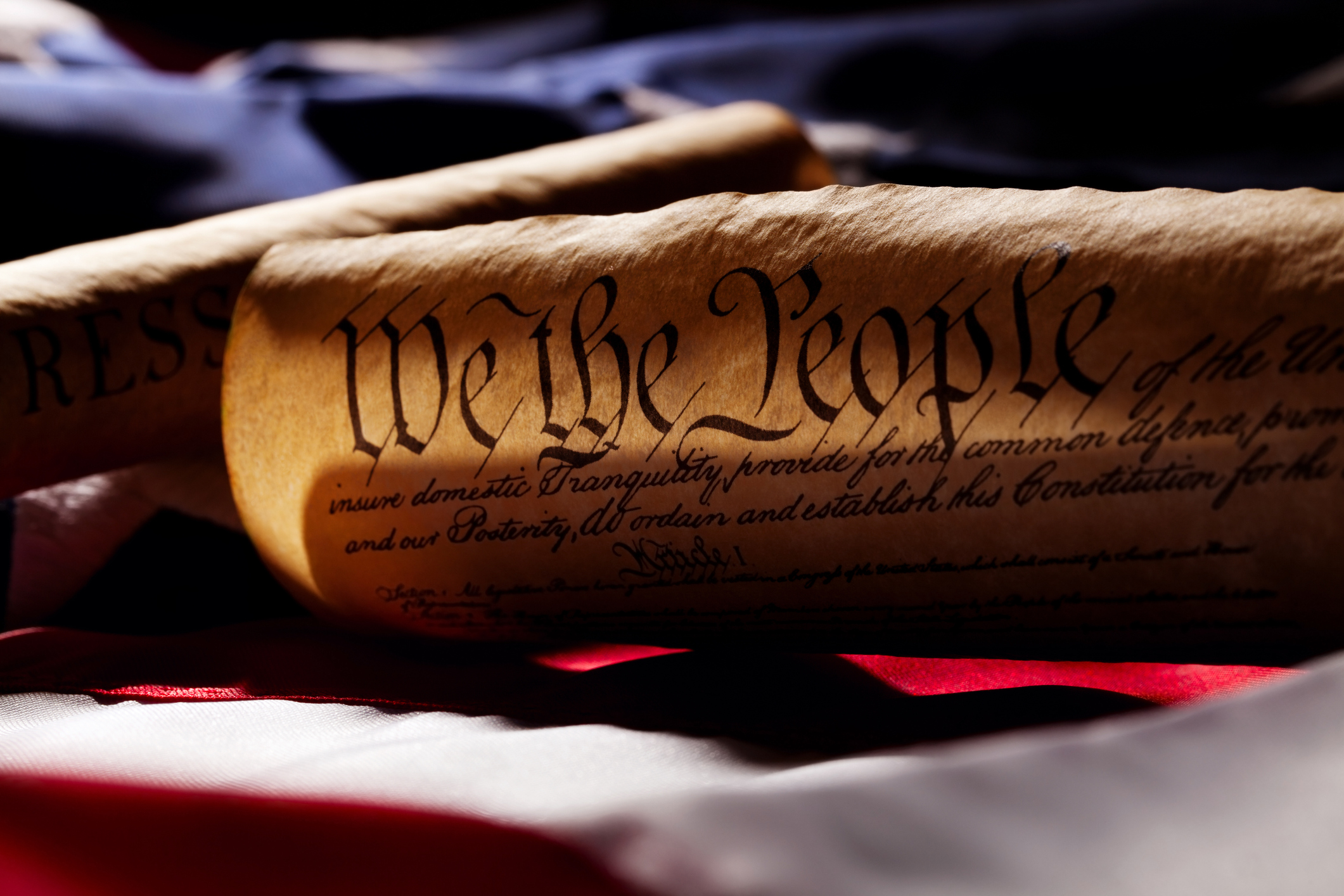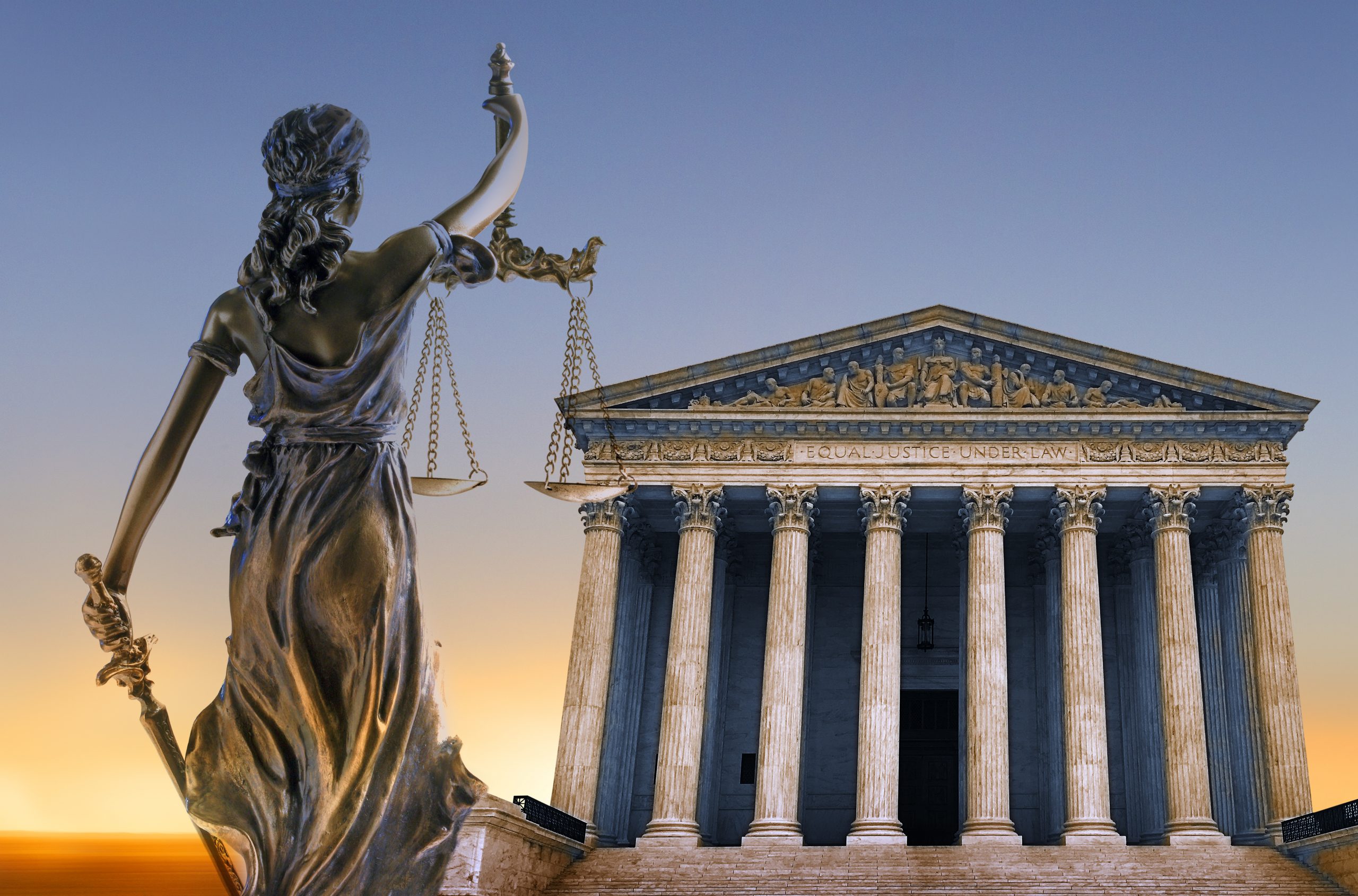Is liberalism still entitled to give itself a hand?
The Preamble Will Not Save Us

The “common good” didn’t mean what its modern proponents want it to mean.
Following the seminal 2020 Bostock decision, which expanded federal civil rights protections to gay and transgender employees, Senator Josh Hawley declared the death of the conservative legal movement in a speech aptly titled, “Was it All for This?” Hawley’s oration sparked a debate among right-leaning legal thinkers about the need to reassess our premises and first principles. Josh Hammer offered an approach he called “common good originalism,” which attempts to thread the needle between Adrian Vermeule’s more radical approach and the Federalist Society’s more conventional one. Holden Tanner asserts a more state-centric, common law restoration project not quite antithetical to Hammer’s “better Originalism.” Hammer retorts that natural law and human reason are too unreliable a foundation upon which to build conservative jurisprudence. A more concrete basis is required.
The debate reveals a flaw in common good originalism, insofar as it finds its justification for substantive moral ends vis-a-vis the common good in the Preamble of the Constitution. Hammer refers to these opening lines of the Constitution as the “telos of the American regime,” and, indeed, in some sense they are—just not in the way that Hammer claims.
Hammer wants a “more concrete” basis for a conservative jurisprudence than Tanner’s natural law and custom. But natural law cannot be escaped, neither normatively nor historically. The concepts of justice, general welfare, and the rest found in the Preamble must be understood in context, specifically the predominate moral and intellectual underpinnings of the founding era itself. These, as Richard Gummere, and to some extent Forrest McDonald, demonstrated, are more traceable to the classical tradition than the Lockean or Enlightenment one. (Though, of course, defining the latter is not a simple as it seems.) If this is true of moral ideas like justice, virtue, and prudence which pervade everyone’s favorite documents from the period then it is truer still of the structural components of those same artifacts. Classical conceptions of the natural law undergird them all.
If the Preamble should be read in its moral, socio-political context, so too must it be read in its structural context. That is, if Hammer wants to be a “better” Originalist then he cannot jettison the original public meaning and function of the Preamble. In brief, its scope and, therefore, function as the regime telos is not as expansive as Hammer might like. It is necessary but insufficient.
This critique takes its cue from Justice John Paul Stevens’s dissent in Van Orden v. Perry (2005), one of the Ten Commandments cases along with McCleary County v. ACLU (2005), wherein Stevens castigated the purportedly Originalist plurality (led by Justice Rehnquist) for its ahistorical eisegesis which read into the Establishment Clause an ecumenical monotheistic character that included both Muslims and Jews. Stevens rightly retorted that the founders would have recognized no such inclusion: “Simply put… the Framers understood the word ‘religion’ in the Establishment Clause to encompass only the various sects of Christianity.”
Of course, Stevens was elated that progress had come to America since the early days of bigotry. It was the plurality’s anachronistic reading of the clause that provoked Stevens’ ire. The actual original understanding of the First Amendment and similar state provisions did not contemplate such a broad and equal preference for all. Even states with no historic establishment such as New Jersey limited religious freedom to Protestants. The majority of original state constitutions contained preference for Christianity; many for Protestantism; several featured religious tests for public office. John Adams reported that article III of his draft of Massachusetts’ constitution was altered by committee, in part, because it did not explicitly preference Protestant public teachers with parish tax support. The Establishment Clause frustrated none of this, as Philip Hamburger and Steven Smith have variously shown.
Backfilling the Preamble
Though Stevens was wrong in his dissenting vote, he was correct in this one aspect of his opinion. The plurality sought original public meaning within a hypothetical historical moment that never existed. It might not rise to the level of sophistry—and the basic conclusion of Van Orden was right—but it was bad historical analysis. A monument of the Ten Commandments at the Texas statehouse was legitimate and deserved protection but not because the founding fathers established constitutional protections equally preferencing all Abrahamic religions. If Justice Thomas is correct in his Espinoza concurrence, and there is good historical reason to think so, then the Establishment Clause, as a federalism amendment, cannot apply to states, which had religious tests, at all.
Like the Van Orden plurality, Hammer is backfilling the Preamble according to present conservative needs and preferences. To the drafters and first commentators on the new Constitution, the Preamble was to be read holistically, not strictly linearly. The aims of the national government were to be understood according to the subsequent structural limitations. Basing a conservative jurisprudence on the federal Preamble misstates the scope and telos of the Preamble itself, namely, to preserve the state republics as the moral and regulatory centers of the nation.
To earlier judges and statesmen, this was simply evident on the face of the relevant documents within the socio-political context in which they were drafted and the type of government they established. The general welfare of the nation, insofar as the Preamble contemplates it, is limited to the function and purpose of the Constitution itself. And any truly conservative jurisprudence must consider and respect the constitutional structure of the regime in which it operates.
Who’s in Charge?
Contrary to popular belief, the Federalist and so-called Antifederalist divide did not hinge on whether states would maintain purview over domestic matters or internal regulation. None other than James Wilson made clear at the 1787 convention that “the state governments ought to be preserved—the freedom of the people and their internal good police depends on their existence in full vigor.” From this concern arose the demand for enumerated powers, which Wilson treated in his famous speech at the Pennsylvania State House the same year.
Likewise, Max Edling, in his new book Perfecting the Union, recounts how Benjamin Franklin assured skeptics that “general welfare” in the Preamble referred only to the external powers enumerated to the federal government, those of international trade and diplomacy, currency, and national security. Edling concludes that “an important, if sometimes overlooked, outcome of the Constitutional Convention was therefore the reconfirmation of the states as the principal political organization in the American federal union.” Edling’s convincing understanding reads the new constitution as an improvement on the Articles of Confederation, though it did not differ in kind, nor extend the remit of national powers, from its predecessor. Fundamentally, both documents are to be understood in the context of eighteenth century republican treatises. It was not pure consolidation but rather a division of labor along an “internal-external axis typical of early modern confederations or ‘federal republics.’”
Only the means necessary to perform national duties were reinvested in the national government. The internal police, or state police power, would remain with the states. Pelatiah Webster, perhaps the most important forgotten influence on the constitution, insisted that nothing in the new Constitution afforded Congress or the federal judiciary the “power to interfere in the least in the internal police or government of any one state, when the interests of some other state, or strangers, or the union in general, are not concerned.” Later, Webster stated this in even stronger, unambiguous language:
the new Constitution leaves all the Thirteen States, complete republics, as it found them, but all confederated under the direction and controul [sic] of a federal head, for certain defined national purposes only, i.e. it leaves all the dignities, authorities, and internal police of each State in free, full, and perfect condition; unless when national purposes make the countroul [sic] of them by the federal head, or authority, necessary to the general benefit.
The other Webster, Noah, chastised certain members of the Pennsylvania ratifying convention for over-reading the supremacy clause when they knew full well, he claimed, that “the powers of the Congress are defined, to extend only to those matters which are in their nature and effects, general… the Congress cannot meddle with the internal police of any State, or abridge its Sovereignty.”
As Edling argues, the concern for the domestic sovereignty of the states by both Federalists and their opponents alike, was rooted in the very events that precipitated secession from England. The Declaration of Independence—which Hammer, following Justice Thomas, gives interpretive weight to—was a “unanimous Declaration of the thirteen united States of America.” The lead complaint against George III by the states was that “He has refused his Assent to Laws, the most wholesome and necessary for the public good.” In other words, the domestic sovereignty for internal policy had been unduly violated.
The first draft of the Declaration of Rights and Grievances (1774) provides the fuller explanation of colonial consternation. The “power of making laws for ordering or regulating the internal polity of these Colonies, is, within the limits of each Colony, respectively and exclusively vested in the Provincial Legislature of such Colony.” Hence, all regulations from parliament violating internal polity sovereignty were declared “illegal and void.”
Per Edling, then, when it came to forming a new Constitution in 1787, the revamped national government of the federal union was doing nothing more than bolstering necessary functions to fill the void of Parliament on external matters but would not have dared to traverse the boundaries that had animated revolt a decade prior. The restoration of colonial domestic sovereignty would be solidified, otherwise dissenters at the convention would never have been persuaded.
It is from this older concept of internal police that we, of course, have our contemporary doctrine of state police power, first clearly articulated in the Massachusetts Commonwealth v. Algers (1851) and later in Mugler v. Kansas (1887). But even in the eighteenth century Blackstone defined “public police and oeconomy [sic]” as “the due regulation and domestic order of the kingdom; whereby the individuals of the state, like members of a well-governed family, are bound to conform their general behavior to the rules of propriety, good neighbourhood, and good manners; and to be decent, industrious, and inoffensive in their respective stations.” This is none other than the well-regulated society that William Novak argues was the expectation of Americans in the early republic—the role of the colonial governments they had grown accustomed to, and fought a war for. Poor relief, transportation, infrastructure, public safety, utilities, and, yes, health were all in view.
The state governments were expected to partner with local townships and the like to regulate domestic affairs according to the common good. This also, of course, included public morality. Gambling, indecency, predatory lending, labor conditions, and intoxicating substances were variously limited or abolished throughout the first hundred years of the republic. Americans and Europeans alike employed the term “police” to refer to “a range of government activities intended to create a specific socioeconomic outcome: the refined, well-ordered, and opulent society,” says Edling.
This, perhaps, especially included religion (the highest good). The broadly Protestant ethos of the states, even post-disestablishment, was preserved through this state-level prerogative: for instance, blasphemy was punished and the Sabbath was upheld on the basis of the predominance of Christianity in the populace of which judicial notice was required. A litany of state cases evidences this: State v. Ambs (Mo. 1854); People v. Ruggles (N.Y. 1811); Harvey v. Boies (Pa. 1829); State v. Chandler (Del. 1837).
But earlier courts also recognized the structural constitutional rationale for internal police powers. In Mott v. Pennsylvania Railroad Co. (1858), Pennsylvania Supreme Court judge Walter Lowrie distinguished between the nature of the federal constitution and those of the several states. The former both constructed a political society (the Union) and framed a government. It extended political society and instituted a government to maintain it. By contrast, the latter “merely construct[ed] forms of government for political societies already constituted and existing.” And the societal rights of those preexisting state governments were by no means “alienated by extending the limits of political society” via the federal constitution. For instance, New Hampshire’s first constitution was occasioned by “the necessity of establishing A FORM OF GOVERNMENT.”
The point being, the distinction in nature of federal and state constitutions yields a distinction in function, and the former did not alter that of the latter. Massachusetts Chief Justice Lemeul Shaw concurred in Commonwealth v. Blackington (1837):
The constitution was not first prepared and drawn up by and for a people who were then, for the first time, establishing political and civil institutions, for their security and government; it was rather a slight remodeling of a social system, by a people who had long enjoyed the protection of law, and security of social order… The constitution itself recognizes this [pre]condition of law and social order.
Common Good v General Welfare
The bottom line is that the power (and interest) to regulate (and judge) for the common good, the salus populi to cite Cicero’s maxim, rather than simply the general stability, longevity, and prosperity of the Union, remained vested in the states. Within the federalist structure reestablished in 1789, the people’s welfare—a phrase that necessarily contemplates particularity—was distinct from the general welfare of the Union. One considered domestic affairs and enjoyed broad leeway, addressing individual and familial units; the other was confined by a delineated list of functions and looked to the preservation and prosperity of the whole, contemplating federated states as its object. Any jurisprudential schema wanting to avoid the charge of ahistoricism must come to terms with this fact.
When Hammer refers to the “general welfare” in the Preamble he is right to recognize its affinity with the parallel phrase “common good.” Indeed, as Hammer has shown, the Federalist authors employed the “common good” repeatedly. It was a staple of the intellectual milieu. The problem is that Hammer does not consider which community is in view when the Preamble invokes a common good synonym insofar as he does not acknowledge the structural limitations of its scope. The community contemplated there is the Union writ large. But the Constitution itself limits “welfare” to decidedly non-particular goods, primarily external and interstate matters.
Within the bounds of original public meaning, this is of little use to legal conservatives facing an onslaught of moral and metaphysical overhauls. This is, in part, why a more structurally coherent state-centric approach best serves them. Structurally, states were always meant to be the laboratories of policy, the moral centers of the Union, the best venues for discerning and pursuing the common good.
On the other hand, the main challenge for Hammer’s thesis is that a common good originalism predicated on the Preamble must discard either the aim of the common good or the methodology of Originalism.
The American Mind presents a range of perspectives. Views are writers’ own and do not necessarily represent those of The Claremont Institute.
The American Mind is a publication of the Claremont Institute, a non-profit 501(c)(3) organization, dedicated to restoring the principles of the American Founding to their rightful, preeminent authority in our national life. Interested in supporting our work? Gifts to the Claremont Institute are tax-deductible.
An appeal to conservatives for an originalism of moral substance.
Digital conditions, not competing intellectuals, will make it so.



